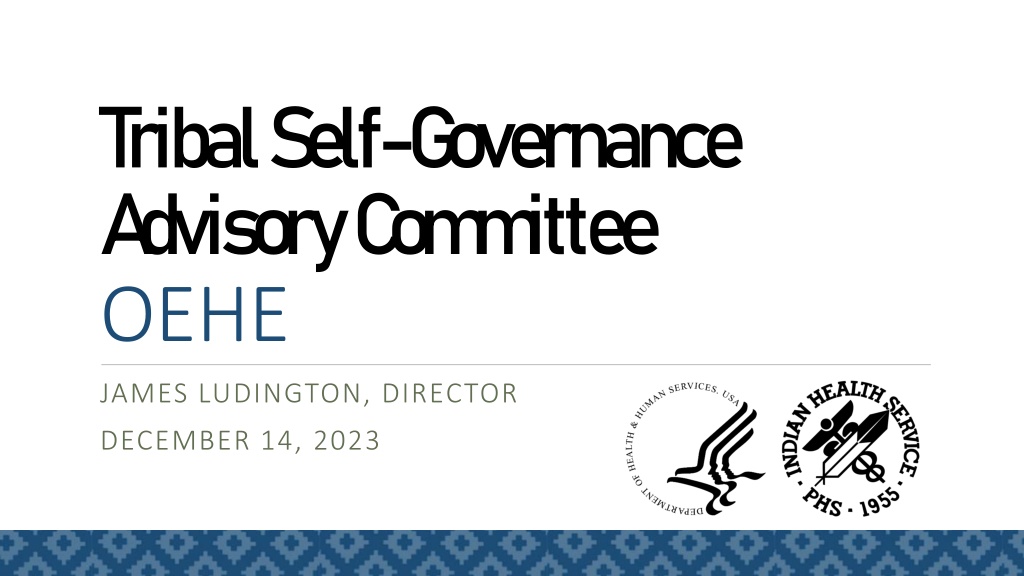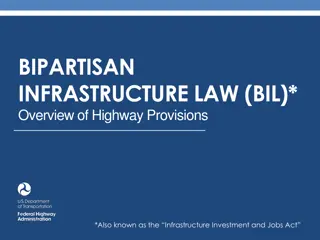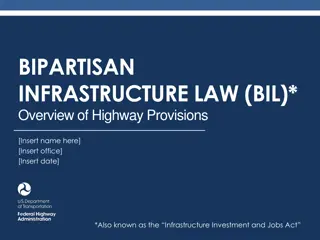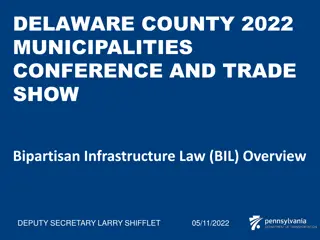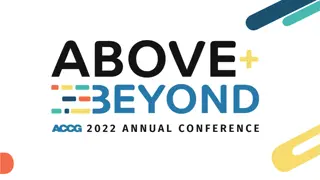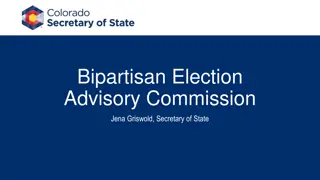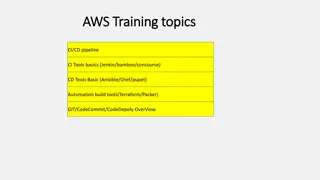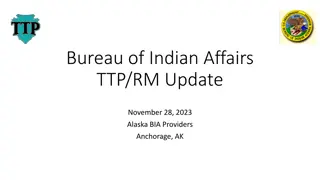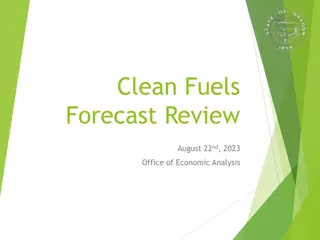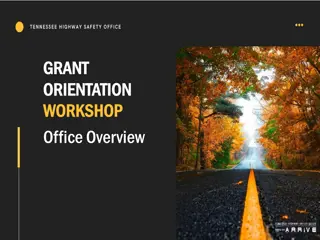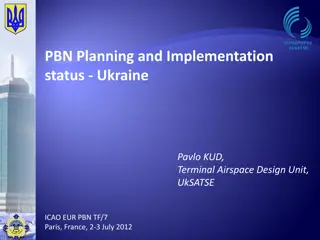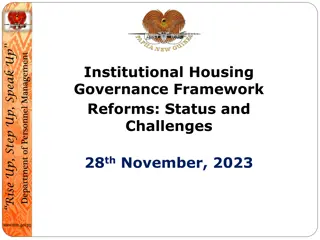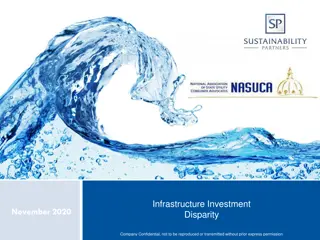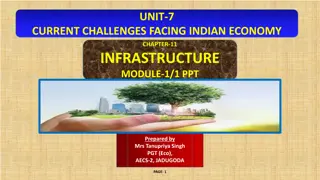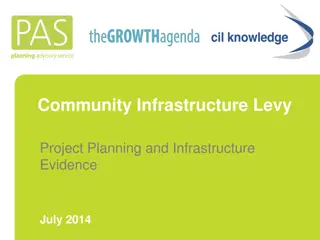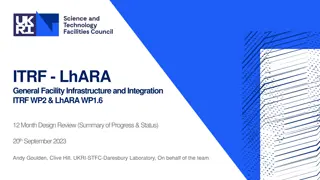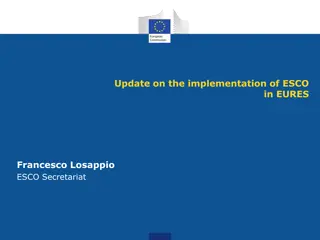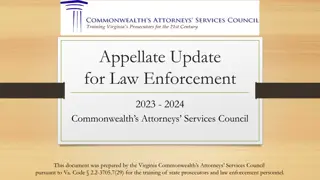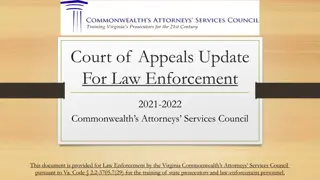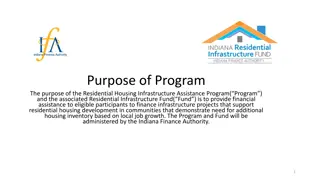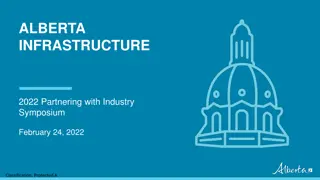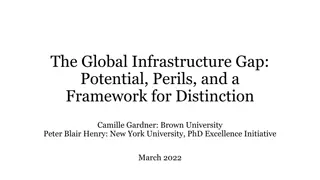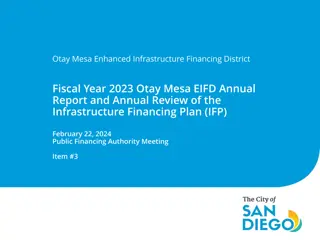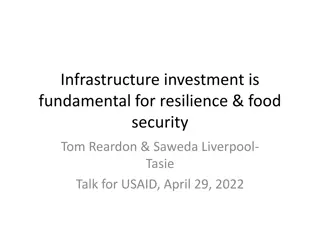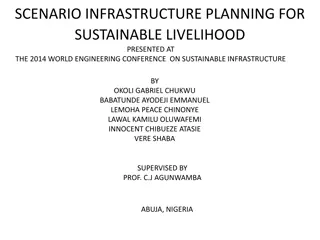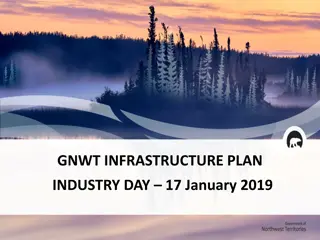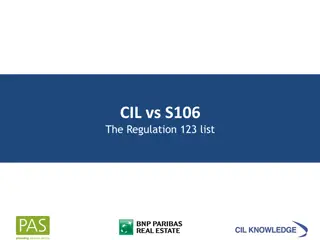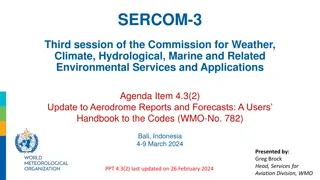Update on Bipartisan Infrastructure Law (BIL) Implementation
The Executive Summary provides insights into the progress and challenges faced in implementing the Bipartisan Infrastructure Law (BIL) for Sanitation Facilities Construction (SFC) through the Indian Health Service (IHS). It outlines the allocation of funds, project milestones achieved, workforce enhancements, and key partnerships. The overview of projects details the funding allocation, project types, and status of IHS-led and Tribe-led initiatives. Specific focus is given to the milestones and progress of Tribe-led projects under the BIL for FY 2022, highlighting the various phases and completion status. The report also includes updates on health care facility construction projects related to the BIL.
Uploaded on Sep 23, 2024 | 0 Views
Download Presentation

Please find below an Image/Link to download the presentation.
The content on the website is provided AS IS for your information and personal use only. It may not be sold, licensed, or shared on other websites without obtaining consent from the author. Download presentation by click this link. If you encounter any issues during the download, it is possible that the publisher has removed the file from their server.
E N D
Presentation Transcript
Tribal Self-G overnance A dvisory C om m ittee OEHE JAMES LUDINGTON, DIRECTOR DECEMBER 14, 2023
Bipartisan Infrastructure Law (BIL) Update
Executive Summary BIL provides $3.5 billion over 5 years to IHS for Sanitation Facilities Construction (SFC). Progress since February 2023 meeting: Obligated 98% of the FY 2022 BIL funds Increased from 30 to 93 projects to procurement phase (Phase III) Increased from 22 to 46 projects under construction phase (Phase IV) Increased SFC program workforce from 27 to 86 staff Improved Partnerships with OPM, AISES, & USPHS Commissioned Corps Challenges and Solutions: Improve Recruitment & Retention Leverage External Engineering Capacity Continue Tribal Engagement 3
Overview of Projects SFC receives $700 million per year for 5 years under BIL, along with ~$200 million/year in annual appropriations. Projects are either IHS-led (Direct Service) or Tribe-led (Title V). The first $700M from BIL for FY 2022 was announced in May 2022 for 454 projects. 327 IHS-led projects 127 Tribe-led projects An additional $700M from BIL for FY 2023 was announced in September 2023 for 197 Tier 1 projects. FY2023 IHS and Tribal project agreements to be completed & signed by 01/31/2024. 135 IHS-led projects (90 BIL + 45 FY2023 Enacted), Note: The Total IHS-led projects decreased from 136 to 135 because one project in the PO Area was funded by others after the FY 2023 Spend Plan was approved 61 Tribe-led projects (43 BIL + 18 FY2023 Enacted) None of the SFC projects that were funded off of the SDS list are Shovel Ready . Most BIL funded projects are in the construction documents phase. 4
FY 2022 Projects Milestones Tribe-led Projects (Title V) PHASE II Construction documents PHASE I Project development PHASE III Procurement PHASE IV Construction Process Construction Document Complete move to Procurement * Project Document Complete Milestone Construction Begin 2025 Timeframe (End-of-Year) 2024 2023 121 (95%) Projection By Timeframe 127 (100%) 100 (77%) 1 (1%) 127 (100%) 12 (10%) Status as of November 8, 2023 * Missing milestone data on 20 projects. Important Note: Tribes that have compacted the SFC Program Delivery are not obligated establish project milestone goals under the compacted agreements with the IHS. 5
Health Care Facility Construction 6
Programs Programs HCFC Priority Projects Joint Venture Construction Program (JVCP) 7
Priority Projects This is the system that funds Inpatient and outpatient facilities. The Priorities were set in 1993 and the IHCIA will not allow any additional projects on the list until the current facilities are funded. Currently there is about $7 billion left to complete on the list. It will take several years before new projects are added to the list. 9
Priority Projects Health Care Facilities Construction Inpatient: Outpatient: Phoenix Medical Center Whiteriver Hospital, AZ Alamo Health Center Pueblo Pintado HC Albuquerque West HC Albuquerque Central HC Gallup Medical Center Bodaway Gap HC Sells ARHC 10
Joint Venture Construction Program The Indian Health Care Improvement Act, authorizes the Indian Health Service Joint Venture Construction Program (JVCP) for establishing projects where American Indian and Alaska Natives tribes can acquire a tribally owned health care facility, in exchange for the IHS providing the initial equipment, then operating and maintenance funding of facility for 20 years. The program was implemented at the request of Tribes to benefit Tribes that have the resources available to fund a new healthcare facility. 12
JVCP Limits TYPE OF HEALTH CARE FACILITY: The program applies only for ambulatory (outpatient) health centers, meeting the current minimum IHS standards of 1,100-user population and a workload of 4,400 primary care provider visits. CONFORMANCE WITH IHS AREA MASTER HEALTH PLAN: The proposed project is to be consistent with the applicable IHS Area Health Services-Facilities Master Plan, in order to maximize the efficient use of the funding. STAFF QUARTERS: Staff quarters needed to support the health care facility are to be a part of the project and are to be a part of the planning documents. The tribe will be the owner of the staff quarters and responsible for all costs for their construction and the subsequent operation and maintenance. 13
JVCP Who is Eligible to Participate? All Federally recognized Tribes planning to construct or acquire an inpatient or outpatient primary health care facility are eligible. The Tribe must demonstrate the administrative and financial capabilities necessary to complete the facility in a timely manner. The Tribe must expend Tribal, private, or other available non-IHS funds to complete the facility. 14
JVCP What the Program Accomplished The JVCP started in 2001. The Tribes have provided over 3 billion square feet of health care facility space. Saving the federal government $2 billion in construction cost. The program serves over 262,000 NA/AN The IHS provides over 6,500 FTEs to provide health care in the JVCP facilities. 15
